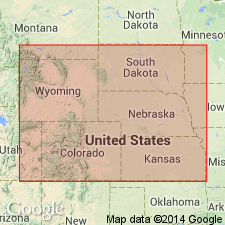- Usage in publication:
-
- Box Butte member*
- Modifications:
-
- Original reference
- Dominant lithology:
-
- Clay
- Sandstone
- Silt
- AAPG geologic province:
-
- Chadron arch
Cady, R.C., 1940, The Box Butte member of the Sheep Creek formation, Nebraska: American Journal of Science, v. 238, no. 9, p. 663-667.
Summary:
Pg. 663-667; [see also Cady and Scherer, 1946, USGS Water-Supply Paper 969]. Box Butte member of Sheep Creek Formation. Proposed for member in uppermost part of formation. At type section, consists of three parts: lower zone, 30 to 40 feet, red and green clay with white concretions, limy sandy silt containing thin beds of brown blocky sandstone, and lumpy brown sandstone that weathers into a honeycomb ledge; middle zone, 25 feet, lumpy and blocky brown sandstone in beds less than 2 feet thick containing two honeycomb limy ledges; and upper zone, 40 feet, partly covered, predominantly green clay with limy white concretions. Exposures showing middle sandstone zone are limited to northern part of Box Butte County, where Niobrara Valley cuts it; elsewhere member consists wholly of clay. Sheep Creek formation, exclusive of Box Butte member, fills narrow channels in top of Marsland formation. Top of Marsland is a white limy slabby caprock as much as 5 feet thick; in most exposures the Box Butte rests upon this cap rock. Sheep Creek channel was filled with brick-red silt and sand; at top of channel fill, the silt was cemented with lime; red clay of lower zone of Box Butte member rests upon this cemented zone. Unit occupies position in geologic column of area between earliest recognized Pliocene (Ogallala) beds and latest known Miocene (Sheep Creek) beds.
Type section: in sec. 27, T. 28 N., R. 49 W., [southside of South Branch Sand Canyon (Dry Creek), bdry. btw. Box Butte Reservoir East and Hemingford 7.5-min quadrangles], Box Butte Co., northwestern NE.
Source: Publication; US geologic names lexicon (USGS Bull. 1200, p. 445-446).

- Usage in publication:
-
- Box Butte member
- Modifications:
-
- Areal extent
- AAPG geologic province:
-
- Denver basin
Summary:
Pg. 131-132. Box Butte member of Sheep Creek formation. Uppermost member of formation. No direct contact between the Box Butte and the Sand Canyon member (new) was observed. Topographically higher outcrops of Box Butte clays north of outcrops of Sand Canyon member at its type locality are considered as indicating higher stratigraphic position of the former. [Age is Miocene.]
Source: US geologic names lexicon (USGS Bull. 1200, p. 445-446).
- Usage in publication:
-
- Box Butte Formation
- Modifications:
-
- Principal reference
- Revised
- AAPG geologic province:
-
- Chadron arch
Galusha, T., 1975, Stratigraphy of the Box Butte Formation, Nebraska: American Museum of Natural History Bulletin, v. 156, art. 1, p. 1-68.
Summary:
Box Butte Formation of Hemingford Group. Raised in rank to formation of Hemingford Group. Subdivided into: (1) the lower Red Valley Member (new), = brick-red silt and sand channel-fill deposits, 30+/- feet thick, previously considered basal part of Sheep Creek Formation (see Cady and Scherer, 1946, USGS Water-Supply Paper 969, p. 32, 34, geol. map, and Cady, 1940, p. 666); and (2) the upper Dawes Clay Member (new), = Cady's (1940) lower zone of Box Butte Member of Sheep Creek Formation, 40+/- feet thick. (Cady's middle and upper zones of Box Butte Member are temporarily included in overlying Sand Canyon Member of Sheep Creek Formation.) Overlies Runningwater Formation of Hemingford Group; contact placed at top of "the Platy Bench." Unconformably underlies Sheep Creek Formation (revised) of Hemingford Group. Age is Miocene (Hemingfordian NALMA).
Principal reference section: in SW/4 sec. 22, T. 28 N., R. 49 W., [northside of South Branch Sand Canyon (Dry Creek), east of County Road 68, approx. Lat. 42 deg. 23 min. 02 sec. N., Long. 103 deg. 01 min. 49 sec. W.], southeastern corner Box Butte Reservoir East 7.5-min quadrangle, Box Butte Co., northwestern NE.
[Cady's (1940, p. 665) type section, which is heavily grass-covered slopes, is retained. Shown south of the canyon in N/2 sec. 27.]
Source: Publication.
- Usage in publication:
-
- Box Butte Formation
- Modifications:
-
- Revised
- AAPG geologic province:
-
- Chadron arch
- Denver basin
Swinehart, J.B., Souders, V.L., DeGraw, H.M., and Diffendal, R.F., Jr., 1985, Cenozoic paleogeography of western Nebraska: Society of Economic Paleontologists and Mineralogists, Rocky Mountain Section, Rocky Mountain Paleogeography Symposium, v. 3, p. 209-229., Reprinted as University of Nebraska-Lincoln, Conservation and Survey Division, Reprint Series, no. 52
Summary:
Pg. 211, 212 (fig. 4), 213 (table 1). Box Butte Formation of Ogallala Group. Transferred to Ogallala Group [†Hemingford Group abandoned]. Consists of gray, greenish-gray, and brown clayey (montmorillonitic) silts containing large calcareous nodules that is a good stratigraphic marker in northern Box Butte and southern Dawes Counties; overlie locally occurring brown to gray, poorly-sorted silty sandstones and sandy siltstones. Maximum thickness 160 feet (49 m). Is older than Sheep Creek Formation and younger than Runningwater Formation (both of Ogallala Group). Age is Miocene, [on fig. 4 base of formation is about 17 Ma +/-].
Source: Publication.
For more information, please contact Nancy Stamm, Geologic Names Committee Secretary.
Asterisk (*) indicates published by U.S. Geological Survey authors.
"No current usage" (†) implies that a name has been abandoned or has fallen into disuse. Former usage and, if known, replacement name given in parentheses ( ).
Slash (/) indicates name conflicts with nomenclatural guidelines (CSN, 1933; ACSN, 1961, 1970; NACSN, 1983, 2005, 2021). May be explained within brackets ([ ]).

